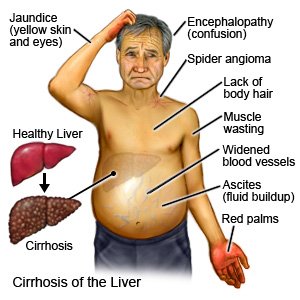Cirrhosis of the Liver
Medically reviewed by Drugs.com. Last updated on Aug 4, 2025.
Cirrhosis is long-term scarring of the liver. The liver makes enzymes and bile that help digest food and gives your body energy. It also removes harmful material from your body, such as alcohol and other chemicals. Cirrhosis is caused by repeated damage to your liver over time. Scar tissue starts to replace healthy liver tissue. The scar tissue prevents the liver from working properly.
 |
WHILE YOU ARE HERE:
Informed consent
is a legal document that explains the tests, treatments, or procedures that you may need. Informed consent means you understand what will be done and can make decisions about what you want. You give your permission when you sign the consent form. You can have someone sign this form for you if you are not able to sign it. You have the right to understand your medical care in words you know. Before you sign the consent form, understand the risks and benefits of what will be done. Make sure all your questions are answered.
Medicines:
- Blood pressure medicine lowers high blood pressure in the portal vein (the vein that goes to your liver).
- Diuretics decrease fluid that collects in a part of your body, such as your legs and abdomen. Diuretics can also decrease your blood pressure. You will urinate more often when you take this medicine.
- Antibiotics prevent or treat a bacterial infection.
Monitoring:
- Abdomen measuring may be done every 4 to 8 hours. A sudden increase in the size of your abdomen may mean you are retaining fluid.
- Intake and output means healthcare providers will keep track of the amount of liquid you are getting. They also may need to know how much you are urinating. Ask how much liquid you should drink each day. Ask healthcare providers if they need to measure or collect your urine.
- A neurological exam is also called neuro signs, neuro checks, or neuro status. A neurologic exam can show healthcare providers how well your brain works after an injury or illness. Healthcare providers will check how your pupils react to light. They may check your memory and how easily you wake up. Your hand grasp and balance may also be tested.
Related medications
Tests:
- Blood tests may be used to check your liver enzymes. This test shows how well your liver is working.
- An ultrasound may be used to check for damage to your liver or other tissues or organs.
- CT or MRI pictures may be taken of your liver. You may be given IV contrast liquid to help your liver show up better in the pictures. Tell the healthcare provider if you have ever had an allergic reaction to contrast liquid. Do not enter the MRI room with anything made of metal. Metal can cause serious injury. Tell the healthcare provider if you have any metal in or on your body.
- A liver biopsy is a procedure used to take a small piece of your liver to be tested for liver damage.
- Esophagoscopy is a test used to look at the inside of your throat and esophagus. A scope with a magnifying glass and a light on the end is gently put into your mouth and throat. Your healthcare provider will look for swollen blood vessels in your esophagus and stomach. The vessels may need to be treated to prevent them from bursting and bleeding.
Treatment:
- A channel may be created inside your liver to increase blood flow. This will help decrease swelling in your abdomen and blood pressure in the portal vein. Your risk for bleeding in your esophagus and stomach is also decreased.
- A liver transplant may be needed if your liver fails.
RISKS:
Without treatment, scar tissue will continue to replace healthy tissue. This can cause severe liver damage, and your liver can fail. You may develop swollen blood vessels in your esophagus and stomach. The vessels may burst and bleed over time. You could go into a coma, or bleed heavily. This can be life-threatening.
CARE AGREEMENT:
You have the right to help plan your care. Learn about your health condition and how it may be treated. Discuss treatment options with your healthcare providers to decide what care you want to receive. You always have the right to refuse treatment.© Copyright Merative 2025 Information is for End User's use only and may not be sold, redistributed or otherwise used for commercial purposes.
The above information is an educational aid only. It is not intended as medical advice for individual conditions or treatments. Talk to your doctor, nurse or pharmacist before following any medical regimen to see if it is safe and effective for you.
Learn more about Cirrhosis of the Liver
Treatment options
- Medications for Alcoholic Cirrhosis
- Medications for Cirrhosis
- Medications for Primary Biliary Cholangitis
Care guides
Symptoms and treatments
Further information
Always consult your healthcare provider to ensure the information displayed on this page applies to your personal circumstances.
